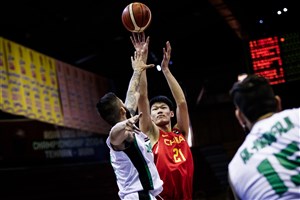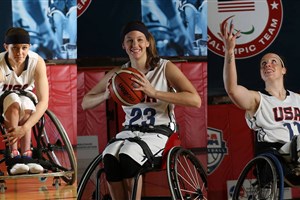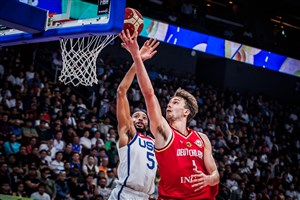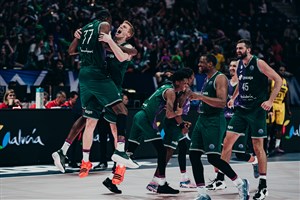
A new rivalry is born
MELBOURNE (Paulo Kennedy's View from Downunder) - What a dramatic finish to the Australian Opals' first dalliance with the FIBA Women's Asia Cup last week - you couldn't have written a much better script, particularly if you're from Japan.
After a red-hot Aussie team nailed 12-of-20 from long range to pip the defending champions in the Group Phase, Saki Mizushima played the role of unexpected hero in the Final to send Japan to the top of the podium.
Playing in her first major international tournament, Mizushima converted her 2-of-8 three-point shooting in her first five games into a gold medal winning 7-of-9 masterpiece in the title game, with all seven trifectas coming after half-time.
I'm sure the Opals were left shaking their heads at the succession of two-handed heaves that sank their chances of a maiden gold, but credit must go to our team - particularly Kelsey Griffin - for hanging through that barrage to almost pinch the win.
Trailing 74-73 with 10 seconds remaining, the Aussies surged forward, a wayward pass from Lauren Mansfield forcing Marianna Tolo to pitch the ball out of a double team to Belinda Snell, who 'went for the gap' as they say in rugby, wedging between two defenders on her drive to the basket.
In a moment of suspense, the trailing referee raised his left arm with a clenched fist to call a foul, but changed his mind midstream, with no doubt a thousand thoughts going through his head, and let his arm fall silently back down by his side.
Snell had the option of scooping the ball to Griffin for the game winner but made the split second decision to fire off-balance - potentially anticipating the whistle that wouldn't come - her shot sailed wide and the rest was Japanese three-peat history.
Mission accomplished
While plenty in cyberspace have used the final loss as an excuse to criticise the coaches, team selection, the game plan and other things, the reality is the Opals headed into this tournament without lead-up games.
After one camp under a new coaching set up, the team had three goals at the Asia Cup:
- Make the top four and qualify for next year's FIBA Women's Basketball World Cup;
- Assess individual players who are on the fringe of the strongest Opals team;
- Assess the game style in its infancy and learn some lessons.
The first they did without raising too much of a sweat, and number two and three the coaching staff will be doing in the coming weeks and months.
I wrote when the initial Asia Cup squad was announced that the line-up, and indeed Australian women's basketball, isn't endowed with a multitude of high-quality international defenders, making team defence and offensive execution critical for future success.
Chasing tail
No doubt one of the main takeaways from the tournament in India will be the need to improve defensively, especially when it comes to the high ball-screen.
The Opals in Bangalore resembled those at the Rio Olympics, reacting to Japan’s on-ball action and spending much of the shot clock chasing tail, hoping shots missed and madly scrambling for rebounds.
As the game wore on and fatigue set in, offensive rebounding became a major issue, Japan grabbing six in the final eight minutes.
While the Japanese style is somewhat unique on the world stage, the challenge of being intelligently disruptive on defence - rather than just reactive to opposition offences - is a key element for Australian teams, whose players haven’t grown up grinding out straight-up half-court affairs.
This is a challenge the Opals were not close to mastering against Japan, their switching reactive rather than proactive, which often dragged them out of help position and rebounding position, which also impacted their offensive transition.
As I said, it's the first tournament of this new era, there are no panic stations, but at the same time this needs to be fixed by next year’s World Cup.
Creating shots
The other issue, offensive execution, also has plenty of room for improvement. While there is some good scoring talent to come back in, there aren't many players who can create their own shot, so system is going to be incredibly important, and that means the point guard position.
At the 2014 World Cup, Erin Phillips and Leilani Mitchell rotated through the one-spot, giving the Opals 40 minutes of quality direction.
At the Rio Olympics, then-coach Brendan Joyce fell into the trap of playing them together and using Tessa Lavey as the back-up. It resulted in a genuine lack of direction at times when the bench unit was on.
While Lavey has shown she can defend international-level point guards, offensively she is not at that level and needs to play off the ball - that's why the Mitchell-Lavey combination worked well off the bench in 2014.
Who's the point?
Lavey's performance in Bangalore showed she is still very much a defence-first player, while starter Lauren Mansfield made her FIBA debut and showed plenty of skill, but also looked very much like a rookie.
She made some great plays, but lacked urgency on defence, was sloppy at times on offence and did not take ownership of the offence late in the final against Japan. Her misdirected lead pass to Marianna Tolo in the final 10 seconds showed real inexperience, and so did her inability to get the ball to a red-hot Griffin in the final 90 seconds when a basket was so desperately needed. To beat the best teams in the world, that level of decision making is crucial.
Mansfield will be up against bigger, longer, stronger, more athletic and smarter players at next year's World Cup, so she will need to prove that she can bring her best more often to earn a spot.
There is also the big question of whether Mitchell or tournament MVP Griffin fills the naturalised player position next year in Spain, but that’s a topic for another column.
A rivalry is born
Reflecting on the Asia Cup, it was a solid first step. From it the coaches will be able to tick off the three main goals and head into the next lot of camps and practice matches with a better knowledge of their players and the kinks in their system.
The biggest question for me is defence. With the likes of Mitchell, Bec Allen, Jenna O'Hea, Rachel Jarry, Liz Cambage, Cayla George, Abby Bishop and Steph Talbot all possible options to come into the team, there should be plenty of versatile offensive players.
It's hard to be a good offensive team taking the ball out of the net, however, and few of the players listed above are known as shut-down defenders so much work must go into a system that allows the Opals to generate some points from that end of the floor if they want to return to the dais in 2018.
Finally, the Opals and Japan have been going at it in practice matches for a few years now, but wasn't it great to see two such hard-fought battles in India with plenty on the line, backing up from a classic match-up in Rio?
With three consecutive continental titles in the trophy cabinet, Japan are rightfully the powerhouse of Asian women's basketball right now, but you know the Opals will be gunning for them in 2019, and even earlier if they cross paths in Spain.
Paulo Kennedy
FIBA
FIBA's columnists write on a wide range of topics relating to basketball that are of interest to them. The opinions they express are their own and in no way reflect those of FIBA.
FIBA takes no responsibility and gives no guarantees, warranties or representations, implied or otherwise, for the content or accuracy of the content and opinion expressed in the above article.
















